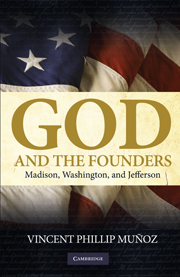Book contents
- Frontmatter
- Contents
- Acknowledgments
- Introduction: The Founders, Religious Freedom, and the First Amendment's Religion Clauses
- PART I THE FOUNDERS' CHURCH-STATE POLITICAL PHILOSOPHIES
- PART II THE FOUNDERS AND FIRST AMENDMENT RELIGION CLAUSES
- 4 Madison's, Washington's, and Jefferson's Church-State Doctrines
- 5 Madison, Washington, Jefferson, and the Establishment Clause
- 6 Madison, Washington, Jefferson, and the Free Exercise Clause
- 7 The Founders v. the Supreme Court
- Conclusion: The Founders and Church-State Jurisprudence
- Appendix A “Memorial and Remonstrance against Religious Assessments” by James Madison, 1785
- Appendix B A Bill “Establishing a Provision for Teachers of the Christian Religion” by Patrick Henry, 1784
- Appendix C A Bill for Establishing Religious Freedom in Virginia by Thomas Jefferson, 1777
- Index
7 - The Founders v. the Supreme Court
Published online by Cambridge University Press: 05 June 2012
- Frontmatter
- Contents
- Acknowledgments
- Introduction: The Founders, Religious Freedom, and the First Amendment's Religion Clauses
- PART I THE FOUNDERS' CHURCH-STATE POLITICAL PHILOSOPHIES
- PART II THE FOUNDERS AND FIRST AMENDMENT RELIGION CLAUSES
- 4 Madison's, Washington's, and Jefferson's Church-State Doctrines
- 5 Madison, Washington, Jefferson, and the Establishment Clause
- 6 Madison, Washington, Jefferson, and the Free Exercise Clause
- 7 The Founders v. the Supreme Court
- Conclusion: The Founders and Church-State Jurisprudence
- Appendix A “Memorial and Remonstrance against Religious Assessments” by James Madison, 1785
- Appendix B A Bill “Establishing a Provision for Teachers of the Christian Religion” by Patrick Henry, 1784
- Appendix C A Bill for Establishing Religious Freedom in Virginia by Thomas Jefferson, 1777
- Index
Summary
The previous two chapters applied the Founders' legal doctrines to First Amendment religion cases and discussed how the Founders' approaches would adjudicate those cases differently. This chapter compares the Founders' projected decisions with the actual decisions rendered by the Supreme Court. It also compares the decisions the Founders would have rendered with the positions taken by individual Supreme Court justices who have been influential in the development of modern church-state constitutional law. The data collected reveal that the Supreme Court has not consistently adopted any one Founder's approach. The votes of individual Supreme Court justices, however, show high degrees of correlation with individual Founders.
THE FOUNDERS V. THE SUPREME COURT
Table SC 1 illustrates the ratio of cases in which each Founder's approach would accord with the Supreme Court decisions discussed inChapters 5 and 6.
For the cases discussed inChapters 5 and 6, the Supreme Court has not rendered decisions that consistently have corresponded to any one of the Founders' approaches. For the different types of cases, the highest frequency of similarity lies between the Court and Madison in cases pertaining to religion in public schools. In six of the seven cases discussed (excluding Newdow, which the Supreme Court did not decide on Establishment Clause grounds), the Supreme Court reached the same result as Madisonian noncognizance. Perhaps surprisingly, the Jeffersonian approach would have allowed prayer in public schools on three occasions that the Court did not – in Vitale, Jaffree, and Santa Fe.
- Type
- Chapter
- Information
- God and the FoundersMadison, Washington, and Jefferson, pp. 196 - 205Publisher: Cambridge University PressPrint publication year: 2009



